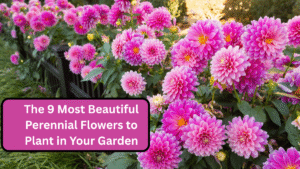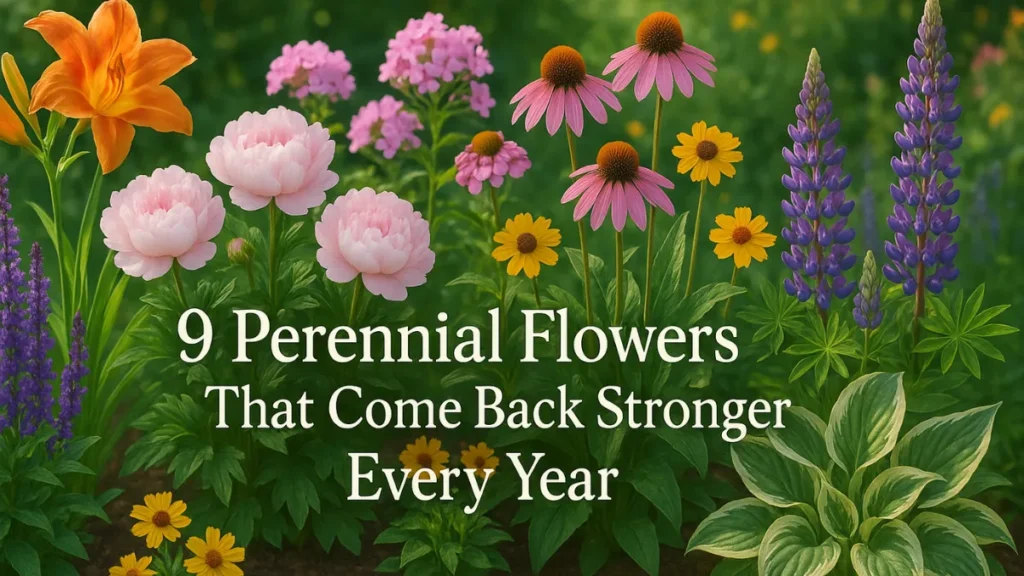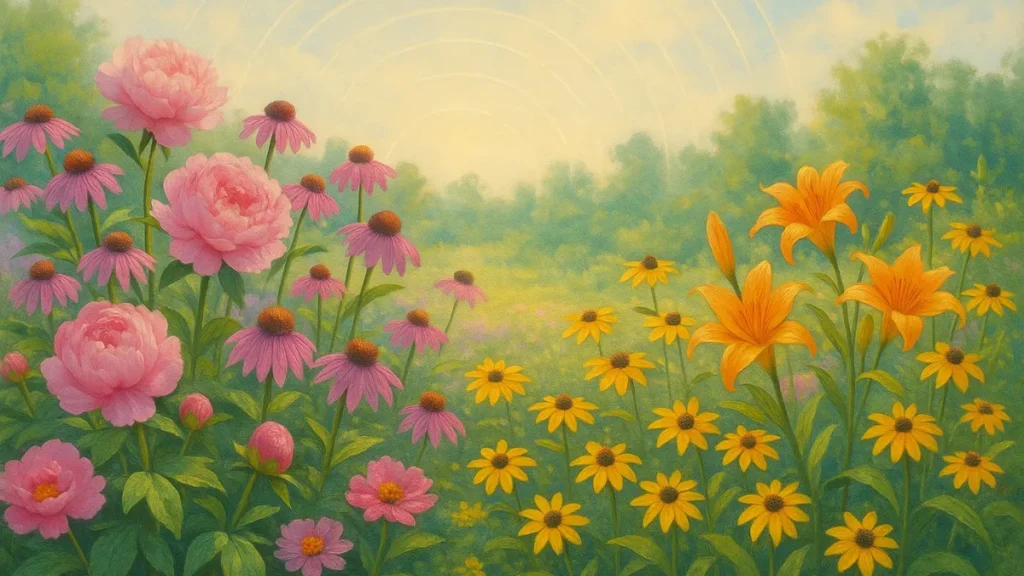If you’re looking to create a garden that thrives year after year, planting perennial flowers is the way to go. These hardy plants come back season after season, providing reliable beauty with minimal effort. Whether you’re a seasoned gardener or a beginner, choosing the right perennials can transform your outdoor space.
From vibrant peonies to elegant lavender, perennial flowers offer a wide variety of colors, shapes, and sizes to suit every garden style. In this guide, we’ll explore nine of the most beautiful and easy-to-grow perennial flowers that will add charm, color, and texture to your garden.
These plants are not only low-maintenance but also provide food and shelter for pollinators like bees and butterflies, making them a great choice for any eco-friendly garden.
1. Lenten Rose
Lenten Rose, also known as Helleborus orientalis, is a stunning perennial flower that blooms in early spring, sometimes even before the last snow has melted. Known for its ability to thrive in shade, the Lenten Rose is perfect for adding color to those darker corners of your garden.
The flower features nodding, cup-shaped blooms in a variety of colors, including white, pink, purple, and even deep maroon. Its leathery, evergreen leaves provide year-round interest, making it a valuable addition to any garden.
Lenten Rose is also low-maintenance and deer-resistant, which makes it ideal for gardens that experience a lot of wildlife activity. Its ability to tolerate cold temperatures and its early bloom time make it a favorite among gardeners looking for a spring surprise.
2. Peony
Peonies (Paeonia species) are beloved for their large, fragrant blooms that emerge in late spring and early summer. These flowers are often associated with elegance and are commonly used in floral arrangements due to their striking appearance.
Peonies can come in a variety of colors, including shades of white, pink, red, and purple. Some varieties even have ruffled petals that add a touch of romance and softness to the garden. Peonies thrive in full sun and well-drained soil, and they are long-lived, with some plants living for decades if cared for properly.
Beyond their beauty, peonies are also known for attracting pollinators such as bees and butterflies, making them an excellent choice for those seeking to support local wildlife. With proper care, they can continue to bloom year after year, becoming more beautiful and abundant as they mature.
3. Penstemon
Penstemon, often called “beardtongue,” is a vibrant perennial that produces tubular flowers in a range of colors, including shades of pink, purple, red, and white. These plants are perfect for gardeners who want to add vertical interest to their flower beds, as their spikes of blooms grow tall and attract attention from a distance.
Penstemons are favored for their drought tolerance and ability to thrive in well-drained, rocky soils, making them an excellent choice for xeriscaping or low-water gardens. Additionally, they are known for their long blooming period, typically from late spring to early summer, and their ability to attract hummingbirds and butterflies.
Some varieties of Penstemon are more tolerant of heat, while others are suited to cooler climates, so it’s essential to choose the right cultivar for your specific growing conditions.
4. Lavender
Lavender (Lavandula species) is a fragrant perennial that is not only beautiful but also incredibly useful. Its tall, spiky flower stalks are often a lovely purple or blue, adding a calming and soothing touch to any garden.
Lavender thrives in full sun and well-drained soil, and it is relatively low-maintenance, requiring minimal watering once established. The aromatic flowers can be used in culinary dishes, made into essential oils, or dried for crafts and sachets.
Lavender is also known to attract pollinators, including bees and butterflies, making it an excellent choice for gardeners looking to support local wildlife. Additionally, lavender is highly drought-tolerant and can be used in both traditional garden settings as well as in more rustic or Mediterranean-inspired landscapes.
5. Coral Bells
Coral Bells (Heuchera species) are a fantastic choice for gardeners looking to add both color and texture to their landscapes. These perennial plants are known for their stunning foliage, which comes in a variety of colors, including shades of red, purple, silver, and green.
Coral Bells also produce delicate, bell-shaped flowers in colors ranging from white to pink and red. These plants thrive in partial to full shade, making them perfect for areas where many other plants might struggle. They are also quite adaptable to different soil types, though they prefer slightly acidic to neutral soils.
Coral Bells are not only attractive but also provide seasonal interest throughout the year, with their colorful foliage persisting through most of the growing season. Their low-growing habit makes them ideal for borders or container gardens.
6. Dahlia
Dahlias are prized for their vibrant, showy blooms, which come in a wide array of shapes and sizes, ranging from small, pom-pom-like flowers to large, dinner-plate-sized blossoms. These perennial flowers thrive in full sun and rich, well-drained soil.
Dahlias are especially popular in summer and fall gardens, where their long blooming season can fill the garden with color even as other plants start to fade. They are available in almost every color of the rainbow, including reds, oranges, pinks, purples, and whites, with some varieties featuring bicolor petals.
Despite their lush appearance, dahlias are relatively easy to care for, although they may need staking to support their heavy blooms. Additionally, dahlias are known for attracting pollinators, particularly bees and butterflies, making them an excellent addition to wildlife-friendly gardens.
7. Balloon Flower
Balloon Flowers (Platycodon grandiflorus) are named for their unique, balloon-like buds that open to reveal star-shaped flowers in shades of blue, purple, and white. These flowers add a touch of whimsy to the garden, with their distinct shape and colorful blooms.
Balloon Flowers thrive in well-drained soil and full to partial sun, making them a versatile choice for various garden settings. They are long-lived perennials that can bloom from mid-summer to early fall, with some varieties reaching up to 2 feet tall.
Balloon flowers are also easy to grow and maintain, requiring only occasional watering and minimal care once established. They are great for borders or containers and are an excellent choice for gardeners looking for a low-maintenance perennial with a charming and unique appearance.
8. Japanese Anemone
Japanese Anemones (Anemone hupehensis) are elegant perennial flowers that bloom in late summer and fall, offering a burst of color as many other flowers begin to fade. These plants produce delicate, daisy-like flowers in shades of white, pink, and lavender, often with a contrasting yellow center.
Japanese Anemones are well-suited to shaded or partially shaded areas, making them an ideal choice for woodland gardens or spots where other sun-loving plants may struggle. They thrive in moist, well-drained soil and can tolerate a variety of conditions, from average to slightly acidic soil.
These flowers are relatively easy to grow and require minimal care, though they may need support as they grow tall and can sometimes become leggy. With their graceful flowers and late-season bloom time, Japanese Anemones add a touch of sophistication to any garden.
9. Cranesbill
Cranesbill, or Geranium species, is a versatile and hardy perennial that is valued for its attractive foliage and vibrant flowers. The name “Cranesbill” refers to the distinctive shape of the seed pods, which resemble a crane’s bill.
These plants produce clusters of bright flowers in shades of pink, purple, blue, and white, and they bloom profusely throughout the growing season, from late spring to early summer. Cranesbill thrives in full sun to partial shade and is tolerant of a wide range of soil types, though it prefers well-drained, moderately fertile soils.
It is also a great groundcover plant, as it spreads slowly but steadily, filling in gaps and providing a colorful carpet of flowers. Cranesbill is relatively low-maintenance and is an excellent choice for both cottage gardens and more formal landscapes. Additionally, it attracts pollinators, making it a beneficial plant for supporting local ecosystems.
Bottom Line:
Perennial flowers are a fantastic way to bring lasting beauty and vibrancy to your garden with minimal maintenance. The 9 flowers we’ve highlighted—Lenten Rose, Peony, Penstemon, Lavender, Coral Bells, Dahlia, Balloon Flower, Japanese Anemone, and Cranesbill—each offer unique qualities that can suit a variety of garden environments.
By planting these stunning perennials, you’ll create a garden that blooms year after year, supports pollinators, and requires little upkeep. With their diverse colors and textures, these flowers will make your garden a true work of art.
FAQs
What are the benefits of planting perennial flowers?
Perennials return year after year, offering long-term beauty with minimal maintenance. They save time and money, as you don’t have to replant each season.
Can perennial flowers grow in shade?
Yes, many perennials, such as Lenten Rose and Japanese Anemone, thrive in shaded or partially shaded areas, making them perfect for darker garden spots.
How do I care for perennial flowers?
Most perennials require well-drained soil, regular watering, and occasional pruning. Specific needs vary, so it’s essential to research each plant’s preferences.
When is the best time to plant perennials?
The best time to plant perennials is in early spring or fall, giving them ample time to establish roots before the weather becomes extreme.



